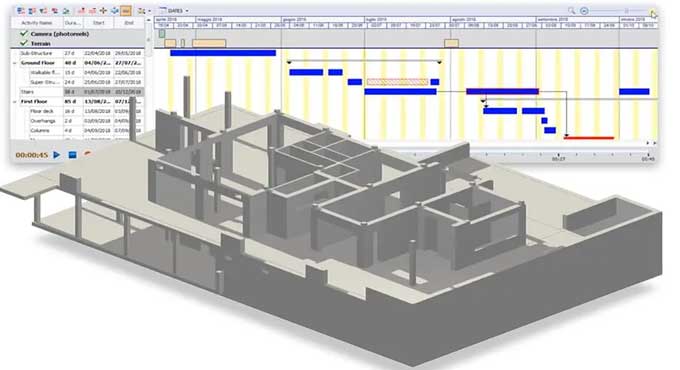The Fourth Dimension of BIM: Unveiling the Power of 4D Simulation
Tweet
Building Information Modeling (BIM) has revolutionized the architecture, engineering, and construction (AEC) industry by providing a comprehensive digital representation of a building's physical and functional characteristics. As technology advances, the integration of additional dimensions into BIM has further enhanced its capabilities. One such dimension, often referred to as the fourth dimension, brings an element of time into the digital construction process.
Understanding the Fourth Dimension
Traditionally, BIM focused on three dimensions – length, width, and height – providing a static representation of a building's design. The introduction of the fourth dimension, time, adds a dynamic element to BIM, allowing stakeholders to visualize and analyze how a project evolves over time. This temporal dimension is crucial in understanding the construction process, sequencing, and project scheduling.
Uses of 4D Simulation
Project Planning and Visualization
4D simulation enables stakeholders to visualize the entire construction process from start to finish. This aids in better understanding the project timeline, identifying potential clashes, and optimizing the construction sequence. Project planners can use 4D simulations to communicate the construction plan more effectively to all project participants, fostering a shared understanding of the project's progression.
Construction Sequencing
Understanding the sequence of construction activities is essential for project success. With 4D simulation, project teams can model and analyze the order of construction tasks, helping to optimize schedules, allocate resources efficiently, and identify potential bottlenecks. This capability is particularly valuable in complex projects where the sequencing of activities is critical to avoiding delays and ensuring a smooth workflow.
Resource Management
4D simulation allows for the efficient allocation and management of resources throughout the construction process. By integrating the temporal aspect, project managers can identify resource conflicts and shortages, helping them make informed decisions to prevent delays and optimize resource utilization. This not only improves project efficiency but also contributes to cost savings.
Risk Analysis
Construction projects are inherently prone to risks, and managing them effectively is crucial. 4D simulation enables stakeholders to conduct risk analysis by considering the temporal dimension. This involves evaluating the impact of potential risks on the project schedule and identifying strategies to mitigate or manage these risks. It provides a proactive approach to risk management, enhancing overall project resilience.
Stakeholder Collaboration
The dynamic visualization provided by 4D simulation facilitates better communication and collaboration among project stakeholders. Whether it's project owners, architects, engineers, or construction teams, everyone can comprehend the project's progress and potential challenges more intuitively. This shared understanding fosters collaboration, reduces misunderstandings, and enhances overall project coordination.
Client Engagement
Clients often struggle to fully grasp construction plans and timelines. 4D simulation bridges this gap by offering clients a realistic and interactive view of the construction process. This not only helps in setting realistic expectations but also allows clients to provide valuable input during the planning phase, contributing to a more satisfactory end result.
The Future of 4D Simulation in BIM
Integration with Other Dimensions
The evolution of BIM doesn't stop at 4D. The industry is moving towards incorporating additional dimensions such as 5D (cost) and 6D (sustainability). The integration of these dimensions with 4D simulation will provide a comprehensive digital twin of a construction project, offering a holistic view that includes not only the physical structure and its evolution over time but also the associated costs and environmental impact.
Advanced Simulation Technologies
As technology continues to advance, the tools and technologies used for 4D simulation are expected to become more sophisticated. Virtual Reality (VR) and Augmented Reality (AR) applications, for instance, may play a more significant role in allowing stakeholders to immerse themselves in a virtual construction environment, providing a more immersive and realistic experience.
Machine Learning and Predictive Analytics
The use of machine learning and predictive analytics is poised to enhance the predictive capabilities of 4D simulation. By analyzing historical project data, machine learning algorithms can provide more accurate predictions regarding project timelines, resource requirements, and potential risks. This data-driven approach will empower project teams to make more informed decisions and further optimize construction processes.
Real-Time Monitoring and Control
The future of 4D simulation lies in real-time monitoring and control. Integrating sensors and Internet of Things (IoT) devices on construction sites will enable continuous data collection, allowing project teams to monitor progress, resource usage, and potential issues in real-time. This level of transparency and control can significantly improve project outcomes by facilitating proactive decision-making.
Global Collaboration and Cloud-Based Solutions
With the increasing globalization of construction projects, cloud-based solutions will play a pivotal role in facilitating global collaboration. 4D simulations hosted on the cloud can be accessed and updated by project teams worldwide in real-time, fostering seamless collaboration among stakeholders regardless of their physical location. This will contribute to more efficient project delivery and improved communication across international teams.
Conclusion
The integration of the fourth dimension into BIM through 4D simulation marks a significant milestone in the evolution of the AEC industry. By incorporating time into the digital representation of construction projects, stakeholders can gain a deeper understanding of the construction process, optimize project schedules, and enhance overall project management.
To get online demonstration, watch the following video tutorial.
Video Source: BuiltEvolve Channel
As technology continues to advance, the future of 4D simulation looks promising, with advancements in virtual reality, machine learning, real-time monitoring, and global collaboration. Embracing these innovations will undoubtedly redefine how construction projects are planned, executed, and delivered in the years to come. The fourth dimension is not just an addition to BIM; it's a transformational tool that empowers the industry to build smarter, more efficiently, and with a greater understanding of the temporal dimension that shapes every construction endeavor.

Gallery
Feel free to contact us for BIM requirements. One of our representative will respond you within 24 Hours. Send us your projects requirement today and grow your project.
Explore More !







